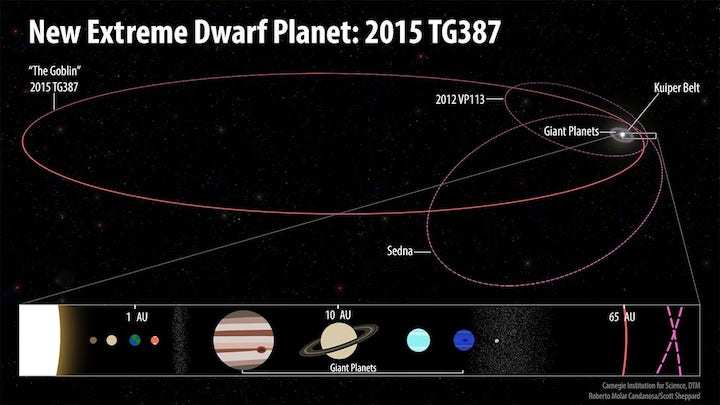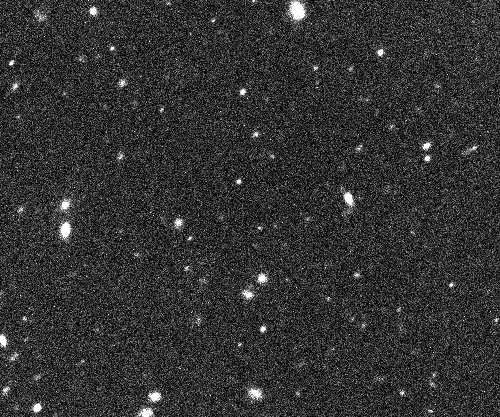3.10.2018

Dwarf planet 2015 TG387's orbit (above) and its extreme distance from the sun (below). (Roberto Molar Candanosa and Scott Sheppard/Carnegie Institution for Science)
A previously unknown dwarf planet circles through the far reaches of our solar system, the International Astronomical Union’s Minor Planet Center announced Tuesday. Officially designated 2015 TG387, the small and spherical object is probably a ball of ice. Astronomers first observed the dwarf planet on Oct. 13, 2015, from the Subaru telescope at Hawaii’s Mauna Kea Observatories. Embracing the near-Halloween October spirit — and for want of something pronounceable — its discoverers nicknamed 2015 TG387 “the Goblin.”
The Goblin is “about 300 kilometers in diameter, on the small end of a dwarf planet,” said Scott Sheppard, an astronomer at the Carnegie Institution for Science in Washington who discovered the object along with colleagues at Northern Arizona University, University of Hawaii and the University of Oklahoma. Dwarf planet Pluto, by comparison, is six times as wide.
Sheppard has embarked on an ongoing survey to find tiny planetoids on the solar system’s outer rim. He’s interested in the Goblin because it “always stays well beyond the giant planet region,” referring to the lineup of our solar system’s four biggest planets: Jupiter, Saturn, Uranus and Neptune. Because 2015 TG387 exists so far away, speaking in terms of miles becomes unwieldy. Instead, astronomers refer to its orbit in astronomical units, or AU, where 1 AU is the distance between the sun and Earth. Pluto sits at an average of 40 AU from the sun. The Goblin comes no closer than 65 AU.
Only a few known objects in our solar system have comparable orbits, such as dwarf planets 2012 VP113 (nickname: Biden) and Sedna. And 2015 TG387′s lopsided elliptical orbit takes it much farther away than those two remote objects — at its farthest, the Goblin reaches 2,300 AU, into a region of space called the Oort cloud. This also means the Goblin takes 40,000 years to complete one orbit of the sun. If we set our calendars by 2015 TG387, then one “Goblin year” ago the last of the Neanderthals walked the earth.
Confirming the orbit of 2015 TG387 required repeated observations, through May 2018, because the planet moves so slowly. The astronomers were lucky to catch the Goblin when they did. As it travels along 99 percent of its orbit, 2015 TG387 is too far and too faint to be detected. Sheppard said he predicts thousands of objects the same size as 2015 TG387 dot the rim of our solar system. But they are likewise too distant to be seen the vast majority of the time. He anticipates astronomers will be able to detect only another dozen or so objects in the next few years of the survey.
“Objects such as 2015 TG387 allow us to probe not only the makeup of the solar system itself but also the gravitational mechanisms that sculpt it,” said Konstantin Batygin, a planetary scientist at the California Institute of Technology who was not involved with the observation. “This is a great discovery indeed.”
The Goblin’s orbit is very skewed, and so is Sedna’s and Biden’s. Sheppard says a large and unknown planet could be “shepherding” these dwarf planets, directing them like a cosmic border collie around the solar system’s fringe.

An illustration of the possible Planet Nine, which could be shaping the orbits of small and extremely distant solar system objects such as 2015 TG387. (Roberto Molar Candanosa and Scott Sheppard/Carnegie Institution for Science)
Sheppard is not the only astronomer to propose that a putative planet, called Planet Nine or Planet X, lurks at the dark edge of the solar system. The planet, if it exists, would be bigger than the Goblin or Pluto. Batygin, in a 2016 paper in the Astronomical Journal, estimated Planet Nine would be up to 10 times as massive as Earth.
As such, Planet Nine would be a “massive perturber,” as Sheppard called it in a 2014 Nature article. Smaller objects like the Goblin have to dance around Planet Nine, or else they would collide with it or be ejected from their orbits. So far, all of the objects Sheppard has spotted appear to dance as predicted.
“This clustering can only be maintained if the solar system hosts an additional, yet unseen, super-Earth type planet,” Batygin said. He added, “I’m running code as we speak that evaluates how the inferred orbit and mass of Planet Nine are affected by this new object.” The Goblin sits right in the middle of the cluster of known objects, he said, and the astronomical search helps scientists home in on Planet Nine’s location.
In 2016, Sheppard told The Washington Post that he put the odds of Planet Nine’s existence at about 60 percent. Now he’s up to 80 percent, he said. “If the trends are true, then we don’t know of another explanation for why they would be grouped in an orbit like this,” Sheppard said. Though the trends have held, the astronomers admit they are dealing with a small number of known objects. For now, Sheppard is eager to find more.
Quelle: The Washington Post
+++
Distant dwarf planet called ‘The Goblin’ could point to Planet X
Our solar system just got a little spookier. A new dwarf planet called The Goblin has been discovered orbiting the sun in the hinterland beyond Pluto, and its elongated path hints that the long-sought Planet X may be travelling through the outer reaches of the solar system as well.
This new dwarf planet, officially called 2015 TG387, is likely a ball of ice and is about 300 kilometres in diameter. It was first spotted by a team of astronomers using the Subaru telescope in Hawaii in October 2015, hence its Halloween-themed name. The International Astronomical Union’s Minor Planet Center announced the discovery on 1 October 2018.
Its extremely elongated orbit means that at times it is 2300 times as far from the sun as Earth is, and it never gets closer to the sun than about twice as far out as Pluto. The dwarf planet moves so slowly that it took years to confirm its orbit with multiple observations.
40,000-year orbit
“Currently we would only detect 2015 TG387 when it is near its closest approach to the sun. For some 99 per cent of its 40,000-year orbit, it would be too faint to see,” said David Tholen at the University of Hawaii in a statement.
He and his colleagues found The Goblin during their hunt for the hypothetical Planet X, a large planet believed to be lurking at the edge of the solar system that may account for disturbances in the orbits of smaller objects like The Goblin. The gravity of such a large planet would tug on smaller objects as they pass by, potentially herding them into a cluster of objects orbiting together – like the one The Goblin is part of.
The most distant objects in our solar system tend to have similar elongated orbits. The team ran simulations that included a Super-Earth-like planet in the distant solar system, and found that such a planet would stabilise The Goblin’s orbit.
“These simulations do not prove that there’s another massive planet in our solar system, but they are further evidence that something big could be out there,” said Chad Trujillo at North Arizona University in a statement.
Quelle: NewScientist
+++
New Object Found in Far Outer Solar System
A newly found body in the extreme backwaters of the solar system incrementally bolsters the case for an undiscovered planet lurking far from the Sun.
Officially dubbed 2015 TG387 and nicknamed “The Goblin”, the object resides in the inner Oort Cloud, a region beyond the Kuiper Belt that until now harbored only two other known bodies: the dwarf planet Sedna and the less well-known 2012 VP113.
The Goblin keeps its distance from the Sun, never coming closer than about 65 astronomical units (a.u.), or just under twice Pluto’s closest approach. However, that’s downright cozy compared to how far out it goes. The Goblin’s highly elongated orbit takes it to a whopping 2,300 a.u., much farther away than its two comrades in the inner Oort Cloud.
The discovery was announced October 2nd by the International Astronomical Union’s Minor Planet Center.
Scott Sheppard (Carnegie Institution for Science) and colleagues discovered 2015 TG387 in images acquired in late 2015 at the 8.2-meter Subaru Telescope in Hawai‘i. At the time, 2015 TG387 was about 80 a.u. from the Sun. Since then, the team has been using other telescopes to track the object and refine its orbit. They estimate that the body is roughly 300 kilometers wide, roughly the width of Saturn’s moon Hyperion.

Discovery images of 2015 TG387, taken 3 hours apart at the Subaru Telescope on October 13, 2018. 2015 TG387 is the dot moving near the center.
Scott Sheppard
Extrapolating from the three objects now known in the inner Oort Cloud, the team estimates that this largely unexplored region of space might harbor roughly 2 million bodies wider than 40 kilometers. That puts the mass of this ensemble on par with the Kuiper Belt.
The bodies in the inner Oort Cloud, along with a smattering of other objects well beyond Neptune, are so remote that they are immune to the gravitational machinations of the known planets. That makes them unique probes for unknown forces at the limits of the solar system. For example, their aligned orbits suggest that a ninth planet, several times as massive as Earth, awaits discovery out there. While 2015 TG387 doesn’t make or break that case, the team’s simulations indicate that its orbit is at least consistent with a planet’s presence.
Quelle: Sky&Telescope

